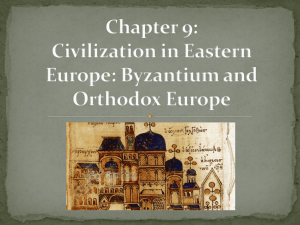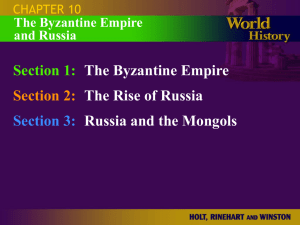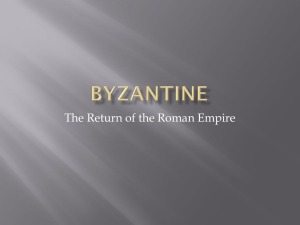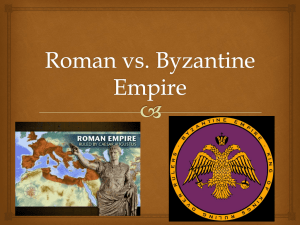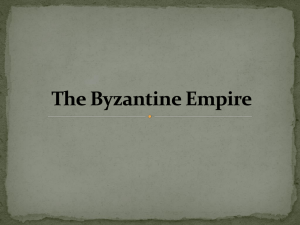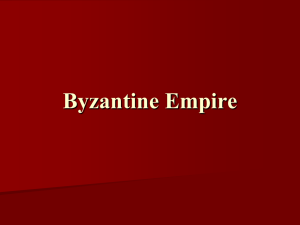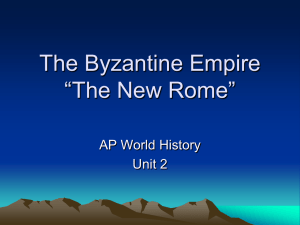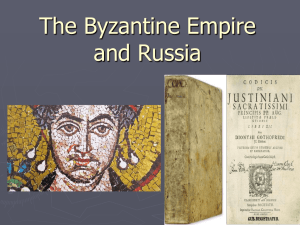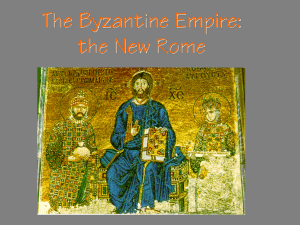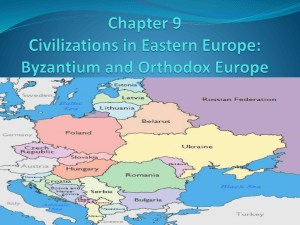The Byzantine Empire - Ms. Sheets` AP World History Class
advertisement
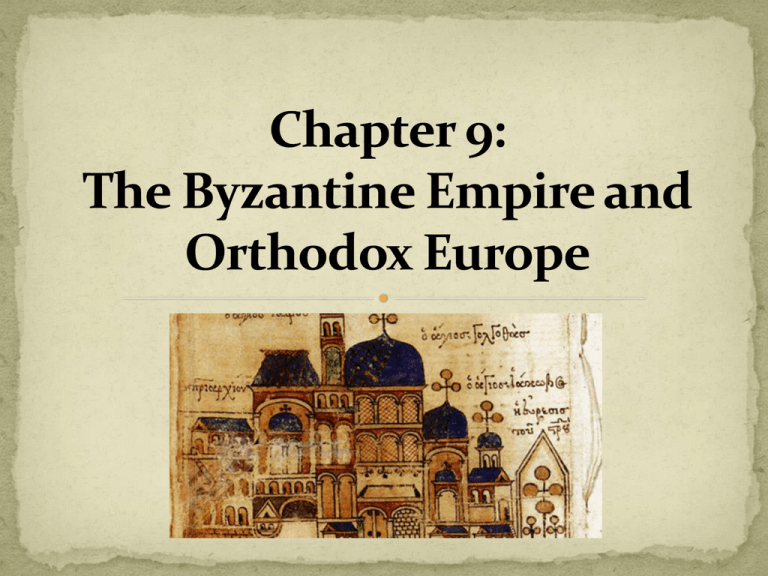
Ms. Sheets AP World History Post-Roman Empire: Political and Religious Divisions • Two Christian civilizations develop out of the splitting of Roman Empire. • East (Greek Orthodox) (Byzantine Empire) • West (Roman Catholic) • Civilizations expand and spread north largely because of religious missionaries and inability to convert one another. • Religions are culturally, and later even organizationally, separate Byzantine Empire • 324 CE: Emperor Constantine of Roman Empire built Byzantium/ Constantinople • 476 CE: Western half of empire collapses; division between West/East • In East, Constantinople is the capital (cosmopolitan, opulent, wealthy) • Involved in Mediterranean and Central Asian commerce • Greek/Eastern Orthodox Christianity • Retain strength despite rapid growth of Islam • Spread culture and politics to parts of world that had not been controlled by any major civilization • Balkans, western Russia Quick Review Question After the Roman Empire collapses in the West, what becomes of each “side” (East vs. West)? Justinian (Reigns 527-565) • Most significant Byzantine ruler 1) Military gains and huge expansion to rebuild original Roman Empire • Gains in North Africa and Italy 2) Systemizes Roman legal code • Influences future law codes in Europe • Reduces legal confusion; united and organized the new empire 3) Projects to renovate Constantinople • Hagia Sophia – engineering and architectural achievements (dome) 4) Makes Greek language official Byzantine Height under Justinian Hagia Sophia • Light • Minarets • Mosaics Quick Review Question What were Justinian’s accomplishments? Muslim Pressure and Byzantine Defenses • After Justinian, Byzantine rulers’ primary concern was defense against Muslim invaders • Able to hold off Muslims in general, but with losses in Mediterranean • Muslim naval fleet is skilled vs “Greek fire” • Empire’s size/strength reduced • Economic burdens and loss of territory from Muslim wars • Increase in taxes; increase in wealth for upper class • Weak emperors; aristocratic estates grow larger Byzantine Politics • Rulers saw themselves as Roman emperors and as ordained by God; government was seen as continuation of Roman Empire • Emperors were head of government and church • Complex bureaucracy (open to all classes but aristocrats dominate). • Bureaucracy helped to organize empire politically, socially, and economically. • Provincial governors appointed • Spy system created loyalty • Troops recruited locally and given land for services • Hereditary military leaders gain too much power Monomachus Byzantine Culture • Creativity in Architecture (domed buildings) • Richly colored religious mosaics in a distinct Byzantine style • Flat, frontal, formal • Icon paintings (paintings of saints and religious figures) • Cultural life blended Hellenism and Orthodox Christianity • Trade: silk production learned from China Monomachus, Christ, and Empress Zoe Great Schism (1054) • Separate paths emerge over disagreements well before official “split” Roman Catholicism (West) Greek Orthodox (East) Political & Religious Power Religion > State Caesaropapism (State > Religion) Clerical Celibacy Yes No Eucharist Unleavened Leavened Bible Latin (inaccessible) Greek (accessible) Influences Roman law Greek philosophy • 1054: Mutual excommunication (Patriarch Michael and Pope Leo IX) • Church splits into two traditions: Greek/Eastern Orthodox and Roman Catholicism Byzantine Decline • Decline begins after 1054 (Church schism) 1) 1071: Battle of Manzikert (Seljuk Turks take most of Central Asian provinces; removes important sources of taxes, food, trade) 2) Independent Slavic states (Bulgaria, Serbia) emerge which diminish Byzantine power • Break away from Byzantine control 3)1204: Crusaders and Venetian merchants sack Constantinople • 1453: Constantinople taken by Ottoman Turks • 3 Groups contribute to destruction of Byzantines The Byzantine Empire (1000-1100) Byzantine Empire went from a major to minor power after the Byzantine loss at the Battle of Manzikert in 1071 against the Seljuk Turks. Quick Review Question 1) Describe the Great Schism. What are the main points of contention? 2) What contributes to the downfall of the Byzantine Empire? Spread of Civilization in Eastern Europe • Eastern Europe is influenced by Byzantine conquest, Christian missionaries and conversion efforts, and trade routes • 9th c.: Byzantine Christian missionaries (Cyril and Methodius) helped bring Orthodoxy northward into Russia and the Balkans • Create new alphabet: Cyrillic script • Create literacy base in eastern Europe Jews and Christians in Eastern Europe • Competition between Catholics and Orthodox Greeks for converts • Catholic converts are mostly in Hungary, Poland • Monarchies with powerful land-owning aristocrats develops • Influx of Jews to Western Russia/Eastern Europe to escape persecution • Later, called the Pale of Settlement • Migrate into region in large numbers (Poland) • High value placed upon education and literacy for males • Limited professions available; gain strength in local commerce; barred from agriculture • Resented by Christian community The Emergence of Kievan Rus’ • Who are the Russians? • Groups from Asia moved into region during Roman Empire • Agricultural society, ironwork, • Family tribes, villages • Animist religion (sun, thunder, wind, fire) • Conduit for trade between Byzantines and Scandinavia • Luxury products from Silk Roads traded for furs from Scandinavia • 855: large trading city (Kiev) became kingdom under Danish merchant Rurik, first Prince of Kievan Rus’ Politics and Religion in Kievan Rus’ • Vladimir I (980-1015) • What religion to choose? • 1000: Converts to Orthodoxy on behalf of all his people; organizes mass baptisms and forced conversions with military pressure. • Develops Russian Orthodox Church • Controls church and creates literate Russian priesthood • Yaroslav (1019-1054) • Develops and issues unifying formal law code • Arranged marriages with central European royalty • Translates religious literature from Greek to Slavic Conversion of Vladimir I Culture in Kievan Rus’ • Byzantium Kievan Rus’ Russian culture • Attracted to ceremony and luxury of Byzantium • Peaceful trade relationship between Byzantium and Kievan Rus’ facilitates cultural exchange • Greek Orthodox influence on Russian Orthodox Church • Ornate churches • Monasticism develops, stress prayer and charity • Fervent religious devotion; no interest in science, math • Art (icons, illuminated manuscripts), literature (using Cyrillic, focused on religious events) • Peasants were free farmers, and aristocratic landlords (boyars) had less political power than similar Westerners Kievan Decline • Decline from 12th century • Other regional leaders and princes are rivals • Succession struggles within royal family • Central Asian invaders weaken borders • 1223: Mongols invade (Battle of the Kalka River) • Aided by rival princes, Mongols take major cities easily • Control much of Russia for over two centuries • 1453: Fall of Byzantium reduces Russian trade and wealth • Orthodox Christianity and Russian culture remain, despite political chaos provide continuity for community Quick Review Question 1) How does Kievan Rus’ emerge? 2) Describe its culture. 3) What contributes to Kievan decline?

